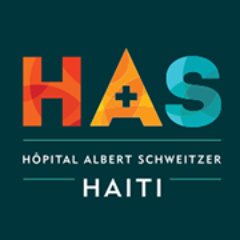Hôpital Albert Schweitzer Haiti
Hôpital Albert Schweitzer Haiti is a hospital and health care facility located in the Artibonite Valley of Haiti, approximately 60 miles northwest of the capital, Port-au-Prince. Named after the Nobel Peace Prize laureate Dr. Albert Schweitzer, the hospital was founded in 1956 by Dr. Larry Mellon and his wife, Gwen Grant Mellon, after being inspired by the work of Schweitzer in Lambaréné, Gabon. The hospital was established with the mission to provide much-needed medical care to the population of the Artibonite Valley, a region that was, and remains, one of the poorest in Haiti.
History[edit | edit source]
The idea for Hôpital Albert Schweitzer Haiti was conceived after Larry Mellon, who was inspired by the life and work of Albert Schweitzer, decided to become a physician in his late 30s. After completing his medical education, Larry and Gwen Mellon founded the hospital in Deschapelles, Haiti, with the goal of bringing modern health care to the underserved population of the region. The hospital was built on the site of a former banana plantation, which the Mellons purchased and transformed into a 131-bed facility. Over the years, the hospital has expanded its services and facilities to meet the growing health care needs of the community it serves.
Facilities and Services[edit | edit source]
Hôpital Albert Schweitzer Haiti operates as a 24-hour full-service facility, providing a wide range of medical services including general medicine, pediatrics, obstetrics and gynecology, surgery, and emergency services. The hospital also runs community health programs focusing on preventive medicine, nutrition, and disease prevention, extending its reach beyond the hospital grounds into the surrounding communities.
In addition to its medical services, the hospital plays a crucial role in public health and disaster response in the region. It has been at the forefront of the fight against cholera outbreaks, malnutrition, and the aftermath of natural disasters such as earthquakes and hurricanes that frequently affect Haiti.
Community Impact[edit | edit source]
The impact of Hôpital Albert Schweitzer Haiti extends far beyond its immediate health care services. Through its community health programs, the hospital has made significant strides in improving public health, reducing infant and maternal mortality rates, and increasing access to health care and education about disease prevention in the Artibonite Valley. The hospital's approach to health care, which combines hospital-based treatment with community outreach and preventive care, has served as a model for other health care initiatives in developing countries.
Challenges[edit | edit source]
Despite its successes, Hôpital Albert Schweitzer Haiti faces ongoing challenges. These include the constant threat of natural disasters, political instability in Haiti, and the ongoing struggle to secure sufficient funding to maintain and expand its operations. The hospital relies heavily on donations from individuals, organizations, and partnerships with other health care institutions to fund its services.
Conclusion[edit | edit source]
Hôpital Albert Schweitzer Haiti stands as a beacon of hope in a region where access to quality health care is often limited. Its founding principles, inspired by the humanitarian work of Albert Schweitzer, continue to guide its mission to serve the most vulnerable populations. Through its comprehensive approach to health care, the hospital not only treats illnesses but also works to improve the overall health and well-being of the communities it serves.
Transform your life with W8MD's budget GLP1 injections from $125
W8MD offers a medical weight loss program NYC and a clinic to lose weight in Philadelphia. Our W8MD's physician supervised medical weight loss centers in NYC provides expert medical guidance, and offers telemedicine options for convenience.
Why choose W8MD?
- Comprehensive care with FDA-approved weight loss medications including:
- loss injections in NYC both generic and brand names:
- weight loss medications including Phentermine, Qsymia, Diethylpropion etc.
- Accept most insurances for visits or discounted self pay cost.
- Generic weight loss injections starting from just $125.00 for the starting dose
- In person weight loss NYC and telemedicine medical weight loss options in New York city available
- Budget GLP1 weight loss injections in NYC starting from $125.00 biweekly with insurance!
Book Your Appointment
Start your NYC weight loss journey today at our NYC medical weight loss, and Philadelphia medical weight loss Call (718)946-5500 for NY and 215 676 2334 for PA
Search WikiMD
Ad.Tired of being Overweight? Try W8MD's NYC physician weight loss.
Semaglutide (Ozempic / Wegovy and Tirzepatide (Mounjaro / Zepbound) available. Call 718 946 5500.
Advertise on WikiMD
|
WikiMD's Wellness Encyclopedia |
| Let Food Be Thy Medicine Medicine Thy Food - Hippocrates |
Translate this page: - East Asian
中文,
日本,
한국어,
South Asian
हिन्दी,
தமிழ்,
తెలుగు,
Urdu,
ಕನ್ನಡ,
Southeast Asian
Indonesian,
Vietnamese,
Thai,
မြန်မာဘာသာ,
বাংলা
European
español,
Deutsch,
français,
Greek,
português do Brasil,
polski,
română,
русский,
Nederlands,
norsk,
svenska,
suomi,
Italian
Middle Eastern & African
عربى,
Turkish,
Persian,
Hebrew,
Afrikaans,
isiZulu,
Kiswahili,
Other
Bulgarian,
Hungarian,
Czech,
Swedish,
മലയാളം,
मराठी,
ਪੰਜਾਬੀ,
ગુજરાતી,
Portuguese,
Ukrainian
Medical Disclaimer: WikiMD is not a substitute for professional medical advice. The information on WikiMD is provided as an information resource only, may be incorrect, outdated or misleading, and is not to be used or relied on for any diagnostic or treatment purposes. Please consult your health care provider before making any healthcare decisions or for guidance about a specific medical condition. WikiMD expressly disclaims responsibility, and shall have no liability, for any damages, loss, injury, or liability whatsoever suffered as a result of your reliance on the information contained in this site. By visiting this site you agree to the foregoing terms and conditions, which may from time to time be changed or supplemented by WikiMD. If you do not agree to the foregoing terms and conditions, you should not enter or use this site. See full disclaimer.
Credits:Most images are courtesy of Wikimedia commons, and templates, categories Wikipedia, licensed under CC BY SA or similar.
Contributors: Prab R. Tumpati, MD



